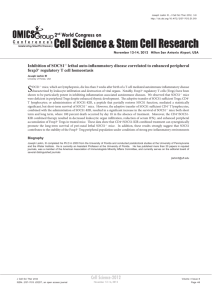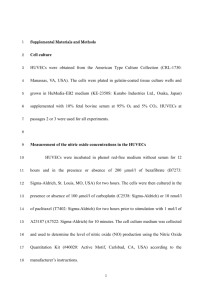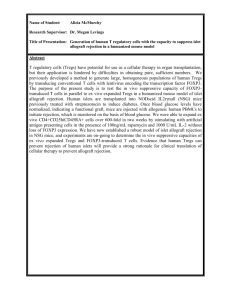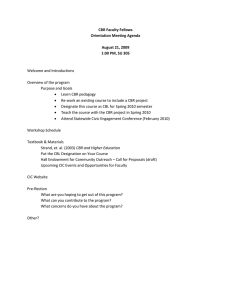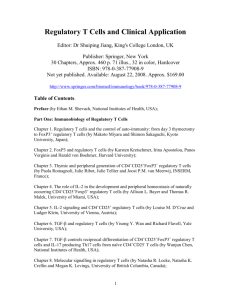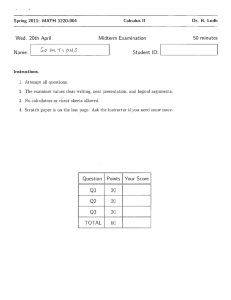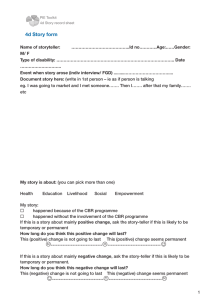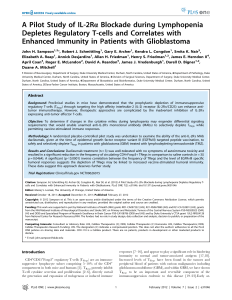Supplement Material: extended methods HUVECs culture HUVECs
advertisement
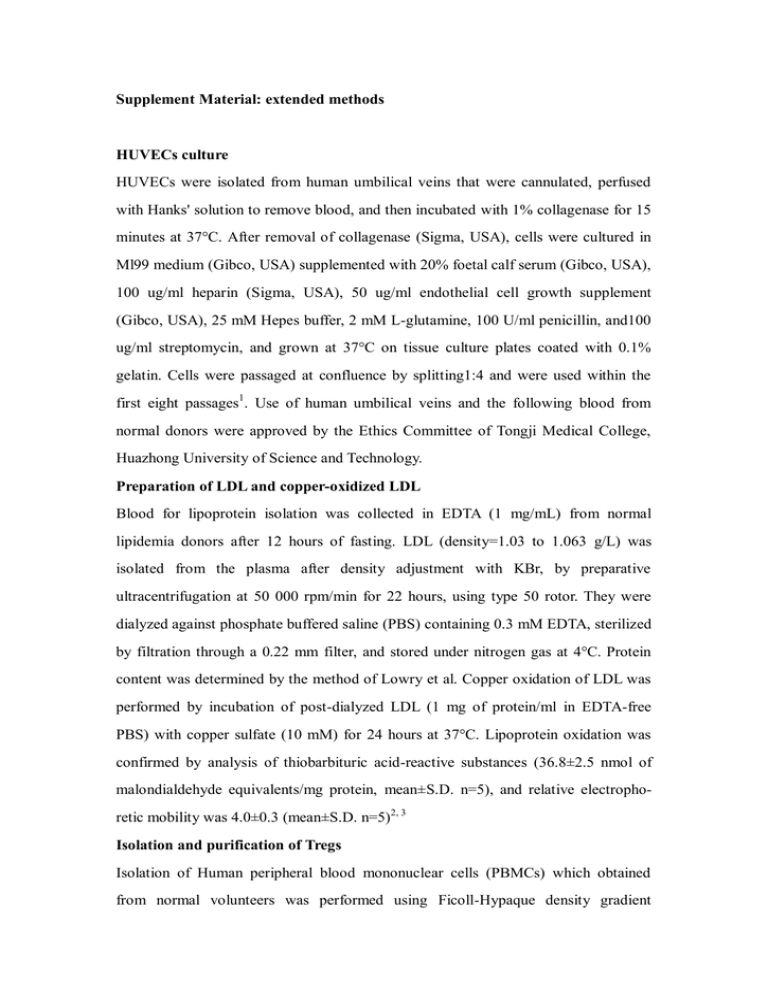
Supplement Material: extended methods HUVECs culture HUVECs were isolated from human umbilical veins that were cannulated, perfused with Hanks' solution to remove blood, and then incubated with 1% collagenase for 15 minutes at 37°C. After removal of collagenase (Sigma, USA), cells were cultured in Ml99 medium (Gibco, USA) supplemented with 20% foetal calf serum (Gibco, USA), 100 ug/ml heparin (Sigma, USA), 50 ug/ml endothelial cell growth supplement (Gibco, USA), 25 mM Hepes buffer, 2 mM L-glutamine, 100 U/ml penicillin, and100 ug/ml streptomycin, and grown at 37°C on tissue culture plates coated with 0.1% gelatin. Cells were passaged at confluence by splitting1:4 and were used within the first eight passages1. Use of human umbilical veins and the following blood from normal donors were approved by the Ethics Committee of Tongji Medical College, Huazhong University of Science and Technology. Preparation of LDL and copper-oxidized LDL Blood for lipoprotein isolation was collected in EDTA (1 mg/mL) from normal lipidemia donors after 12 hours of fasting. LDL (density=1.03 to 1.063 g/L) was isolated from the plasma after density adjustment with KBr, by preparative ultracentrifugation at 50 000 rpm/min for 22 hours, using type 50 rotor. They were dialyzed against phosphate buffered saline (PBS) containing 0.3 mM EDTA, sterilized by filtration through a 0.22 mm filter, and stored under nitrogen gas at 4°C. Protein content was determined by the method of Lowry et al. Copper oxidation of LDL was performed by incubation of post-dialyzed LDL (1 mg of protein/ml in EDTA-free PBS) with copper sulfate (10 mM) for 24 hours at 37°C. Lipoprotein oxidation was confirmed by analysis of thiobarbituric acid-reactive substances (36.8±2.5 nmol of malondialdehyde equivalents/mg protein, mean±S.D. n=5), and relative electrophoretic mobility was 4.0±0.3 (mean±S.D. n=5)2, 3 Isolation and purification of Tregs Isolation of Human peripheral blood mononuclear cells (PBMCs) which obtained from normal volunteers was performed using Ficoll-Hypaque density gradient centrifugation following the manufacturer’s protocol (Human lymphocyte separation medium from Chinese Academy of Medical Sciences Institute of Biomedical Engineering, China). CD4+T cells were isolated from total PBMCs by negative selection using LD column (Miltenyi Biotec, Germany). Purified CD4+T cells incubated with anti-human CD25 magnetic beads (Miltenyi Biotec, Germany), and separated into CD4+CD25+ and CD4+CD25- fractions by positive selection using MS column (Miltenyi Biotec, Germany).The positively selected CD25+ cell fractions were separated again over an MS column to achieve higher purities. As assessed by using fluorescence-activated cell sorting (FACS) (Becton-Dickinson, Oxnard, NJ), purities of CD4+CD25+Tcells and CD4+CD25-T cells were >93% and>99%, respectively. To further confirm the identity of these freshly Tregs, the primers (5'-ACA CCA CCC ACC GCC ACT-3' and 5'-TCG GAT GCC ACA GAT GAA GC-3') were used to measure the expression of Foxp3 mRNA, the intracellular Foxp3 staining was performed with the APC-anti-human Foxp3 staining set (bioscience, USA) according to the manufacturer’s instructions4. Co-culture of T-effector and Tregs CD4+CD25- (Tcon) and CD4+CD25+T cells (Treg) (104 cells/well) were cultured in RPMI medium supplemented with 10% fetal calf serum at different Tcon: Treg ratios (0:1, 1:0, 1:1, 2:1, 4:1 and 8:1) in the presence of anti-CD3 mAbs (50 ng/ml) in 96-well plates (Nun, Germany). All cells were cultured in a final volume of 200 µL in the presence of irradiated 104 T cell–depleted accessory cells (APC) per well. After 48 hours, [3H] thymidine (1 µCu/well) was added for 16 hours before proliferation was assayed by scintillation counting (MicroBeta1450 Liquid Scintillation Counter, Perkin Elmer, USA). Percent inhibition of proliferation was determined from the following formula: (1–3[H]-thymidine uptake (cap) of co-culture of Treg with Tcon divided by cpm of Tcon alone)×100%.Triplicate wells were used in all suppression experiments5. Flow cytometry for detection of HLA DR, CD86, CD80 and VCAM-1 After the incubation period, HUVECs from different groups were incubated with human leukocyte antigen DR (HLA DR)-PE antibody solution, CD86-PE antibody solution,CD80-PE antibody solution and VCAM-1-PE antibody solution (eBioscience, USA) at 4°C for 0.5 h, respectively. And then we washed them two times with PBS which contains 2% bovine serum albumin (BSA) and 0.1% NaN 3. For isotype control, PE-conjugated human anti-IgG1 antibodies (eBioscience, USA) were used. Cells were re-suspended in 500 μL PBS with 1% paraformal-dehyde and immediately processed using FACS LSRⅡ(Becton Dickinson, USA). After correction for unspecific binding (isotype control), the percentage of positive cells were analyzed by the Cell Quest program (Becton Dickinson, USA). Enzyme-linked immunosorbent assay (ELISA) for detection of MCP-1, IL-6, IL-10 and TGF-β Supernatants from different groups were collected and kept frozen at -80°C until the cytokine levels (MCP-1, IL-6, IL-10 and TGF-β) were determined by ELISA assays according to the manufacturer’s instructions (R&D Systems, USA). The results were compared with a standard curve. Each assay was carried out in triplicate for each sample. Absorbance was measured at 450 nm by means of a spectrophotometer. Real-time RT-PCR for detection of VCAM-1, MCP-1, IL-6 and KLF2 Total RNA from different groups of HUVECs were isolated using Trizol reagent (Invitrogen, USA) according to manufacturer’s instruction, respectively. One microgram of total RNA was reverse transcripted using RNA PCR Kit (Takara Biotechnology, Japan) and the resulting cDNA was used as a PCR template. The mRNA levels were determined by real-time PCR with Applied Biosystems Step One Real-Time PCR System (Applied Biosystem, USA) according to the manufacturer’s instructions. GAPDH was used as endogenous control. Primers for human VCAM-1 (5'-CAT CCA CAA AGC TGC AAG AA-3'and 5'-CCT GGA TTC CCT TTT CCA GT-3');MCP-1(5'-CTC ATA GCA GCC ACC TTC ATT C-3' and 5'-CAA GTC TTC GGA GTT TGG GTT T-3');IL-6(5'-CAA ATT CGG TAC ATC CTC GAC GGC-3' and 5'-GGT TCA GGT TGT TTT CTG CCA GTG C-3');KFL2 (5'-GCA CGCAC ACAG GTGAGAAG-3' and 5'- ACCAGTCACAGTTTGGGAGGG-3') and GAPDH(5'-CCA CCC ATG GCA AAT TCC ATG GCA-3' and 5'-TCT AGA CCG CAG GTC AGG TCC ACC-3').PCR reaction mixture contained the SYBR Green I (Takara Biotechnology, Japan), cDNA, and the primers. Relative gene expression level (the amount of target, normalized to endogenous control gene) was calculated using the comparative Ct method formula 2 -ΔΔCt. Electrophoretic mobility shift assay (EMSA) for detection of NF-κB For the preparation of nuclear extracts, HUVECs from different groups were gently lysed in a NP-40 containing sucrose buffer while the nuclei remain intact. After a washing step, the nuclei are suspended in a hypotonic "low salt buffer": the nuclei swell. Then a "high salt buffer" is added slowly: the nucleoplasm is extracted into the buffer while the nuclear envelop stays intact and retains the genomic DNA. The extract is separated from the nuclear envelop/DNA by centrifugation. Light Shift TM Chemiluminescent EMSA kit (Pierce, USA) was used to detect DNA-protein interaction. The sequences of NF-κB consensus oligonucleotides were: forward 5'-AGTTGAGGGGACTTTCCCAGGC-3'; reverse 5'-GCCTGGGAAAGTCCCCTC AACT-3'. For the EMSA, the binding reactions were performed for 20 minutes in 10mmol/L Tris-HCl (pH 7.5), 50 mmol/L KCl, 5 mmol/L MgCl2, 1 mmol/L dithiothreitol, 50 ng/uL poly (dI-dC), 0.05% NP-40, 2.5% glycerol, biotin 3’-end -labeled double-stranded oligonucleotide, and nuclear protein extract. Samples were electrophoresed on a native polyacrylamide gel and then transferred to a nylon membrane. The biotin end-labeled DNA was detected by chemiluminescence. To check if the observed shifted bands are specific for NF-κB, competition tests are run: additionally to the labeled NF-κB probe a 200-fold excess of non-labeled ("cold") oligonucleotide is added in. Transwell experiments Transwell (0.4 um pore size, Corning, Acton, MA) experiments were performed by culturing HUVECs (1×106 cells/well) in the lower well and Tregs (5×105 cells/well) with anti-CD3 mAbs in the inserts. After 48 hours of co-culture, the top compartments (inserts) were removed, and ox-LDL (40 ug/ml) was added for 24h. After the incubation period, HUVECs were collected for further experiments. Fixation of Tregs For fixation experiments Tregs were isolated and divided into four fractions. One part was activated with anti-CD3 mAbs for 48h and fixed with 2% paraformaldehyde for 1 h at 4°C (activated-fixed Tregs); the second part was fixed with 2% paraformaldehyde for 1 h at 4°C without activation by ox-LDL (resting-fixed Tregs); the third part was stimulated with anti-CD3mAbs for 48h (viable Tregs); and the last part was left untreated (resting Tregs). Thereafter, fixated cells were washed extensively and used in regulation assays together with the untreated fraction. This procedure prevents any cytokines production from Tregs yet maintains their cell contact dependent suppressive functions6. References: 1. Wagner AH, Gebauer M, Pollok-Kopp B, Hecker M. Cytokine-inducible CD40 expression in human endothelial cells is mediated by interferon regulatory factor-1. Blood.2002; 99: 520-525. 2. Holven KB, Aukrust P, Holm T, Ose L, Nenseter MS. Folic acid treatment reduces chemokine release from peripheral blood mononuclear cells in hyperhomocysteinemic subjects. Arterioscler Thromb Vasc Biol. 2002; 22:699-703. 3. Ming Li, Jian Chen, Yu-Shu Li, Yi-Bai Feng, Qiu-Tang Zeng. Folic acid reduces chemokine MCP-1 release and expression in rats with hyperhomocystinemia. Cardiovasc Pathol. 2007; 16:305-309. 4. Dieckmann D, Plotter H, Berthold S, Berger T, Schuler G. Ex vivo isolation and characterization of CD4+CD25+T cells with regulatory properties from human blood. J Exp Med. 2001; 193:1303-1310. 5. Livings MK, Sangregorio R, Roncarolo MG. Human CD25+CD4+T regulatory cells suppress naive and memory T cell proliferation and can be expanded in vitro without loss of function. J Exp Med. 2001; 193:1295-1302. 6. Bharat A, Fields RC, Trulock EP, Patterson GA, Mohanakumar T. Induction of IL-10 suppressors in lung transplant patients by CD4+CD25+ regulatory T cells through CTLA-4 + signaling. J Immunol.2006; 177:5631-5638. Supplementary Information: legend for figures I Figure I Tregs down-regulate mRNA expression of VCAM-1, MCP-1 and IL-6 in HUVECs impaired by ox-LDL/LPS. Co-culture system was set up as described in Figure legend 2. Total RNA from HUVECs were collected and VCAM-1, MCP-1, IL-6 mRNA were analyzed by Real-Time PCR. GAPDH was used as endogenous control (A). To explore whether there was a threshold effect for Tregs mediated expression of VCAM-1, MCP-1 and IL-6 in mRNA levels in HUVECs, HUVECs (1×106 cells/well) were cultured without or with various numbers of anti-CD3 mAbs activated Tregs (1×105, 2.5×105, 5×105 cells/well), then with or without(control) ox-LDL for an additional 24h, VCAM-1, MCP-1 and IL-6 mRNA in HUVECs were measured (B). Data are presented as mean±SEM of triplicate wells, and are representative of at least three independent experiments. (* is indicated for V.S. control; # is indicated for V.S. no T; + is indicated for CD25+ V.S.CD25-.*: p<0.05, **: p<0.01, ***: p<0.001; #: p<0.05, ##: p<0.01, ###: p<0.001; +: P<0.05, ++: P<0.01, +++: P<0.001) Figure I
